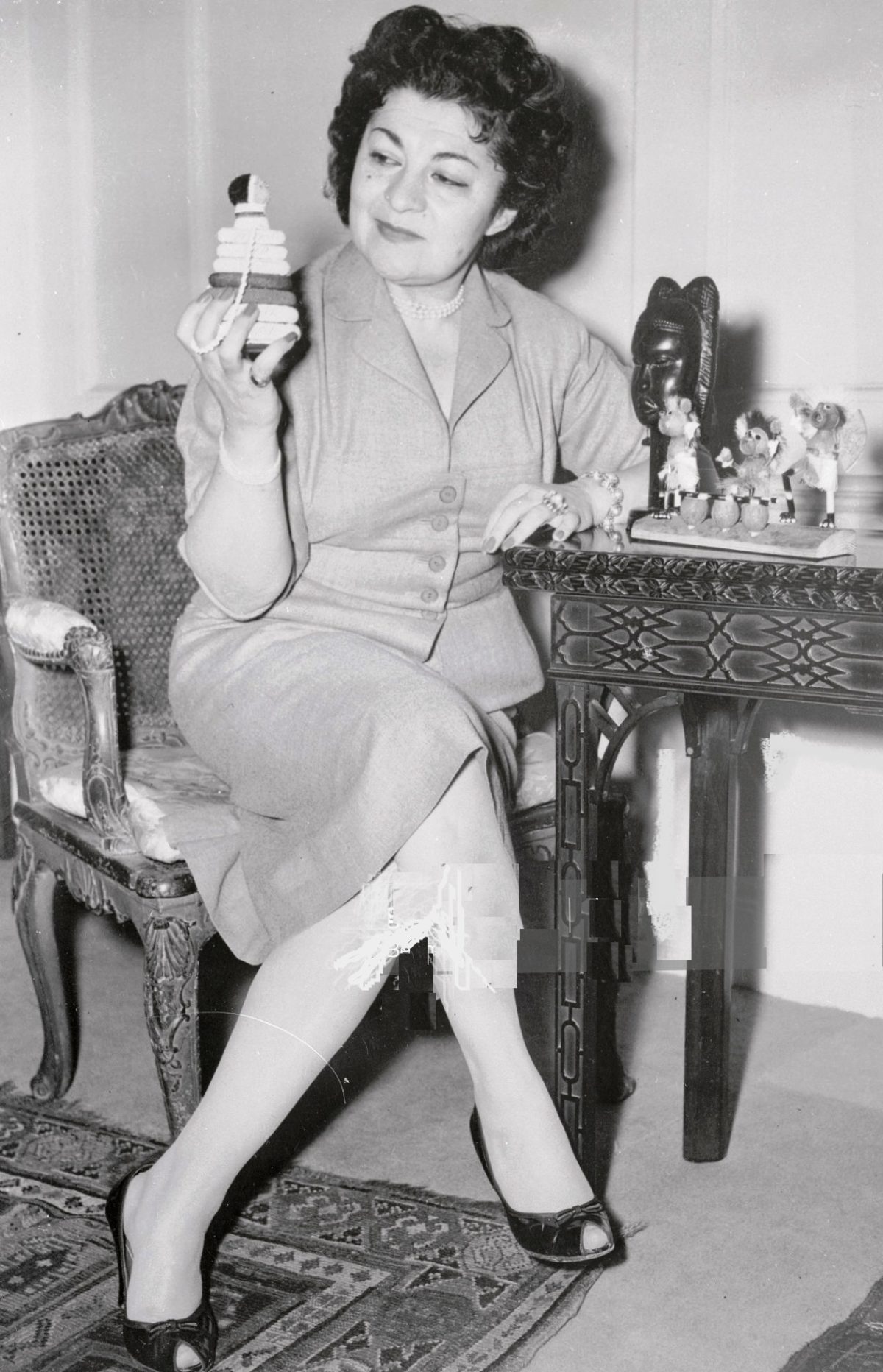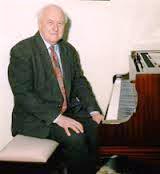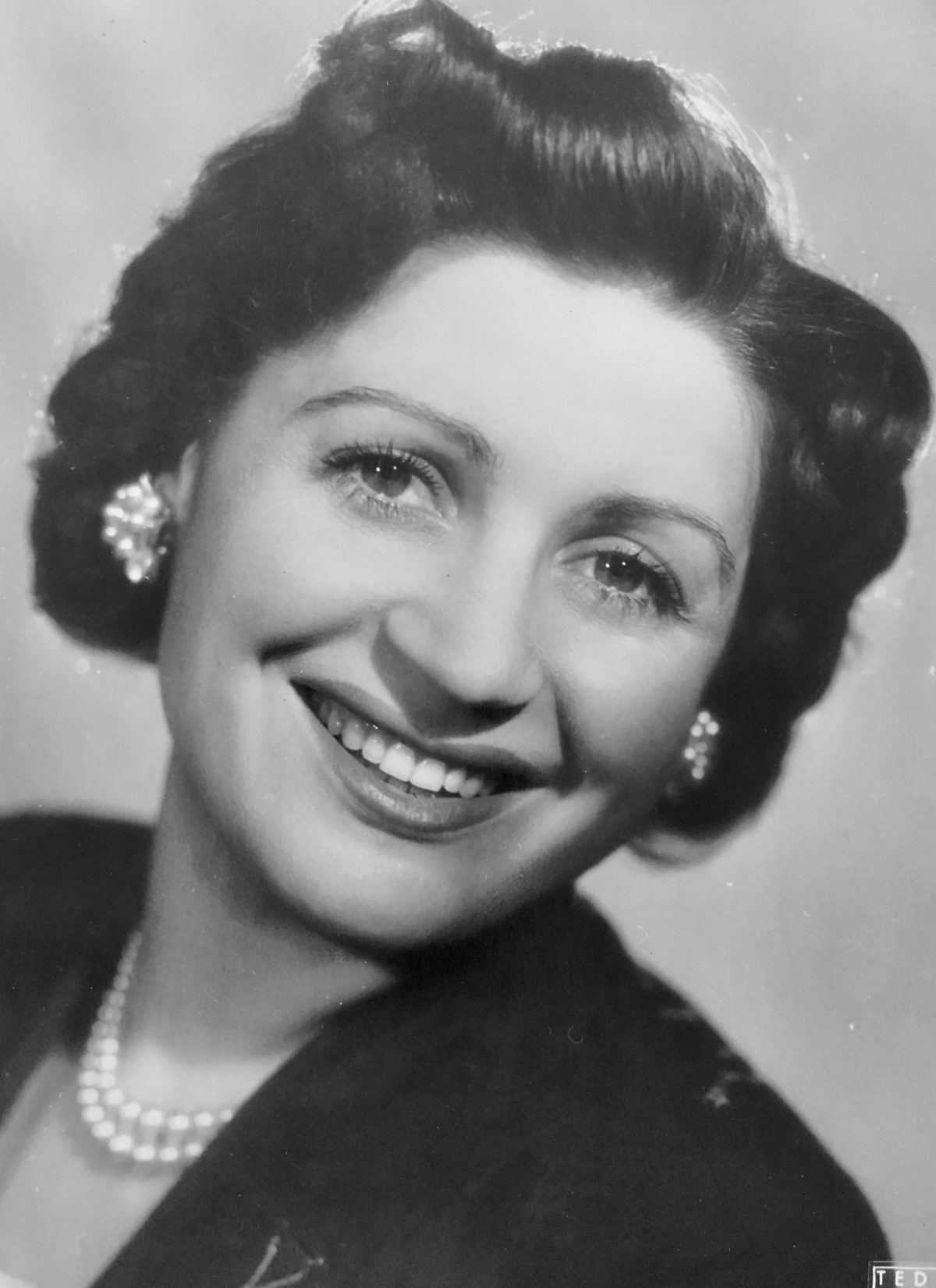.
Gwynne Schrire, a veteran contributor to Jewish Affairs and a long-serving member of its editorial board, is Deputy Director of the SA Jewish Board of Deputies – Cape Council. She has authored, co-written and edited over twenty books on aspects of South African Jewish and Western Cape history. The following article is based on a copy of a 1955 concert programme organised by the Bnoth Zion Association in Cape Town to raise money for the Jewish National Fund.
.
A recent gift to the Cape SA Jewish Board of Deputies of a 1955 Jewish National Fund (JNF) charity programme has brought back memories of a forgotten part of South African Zionist history. Exploring the ramifications of this programme opened up a treasure chest of stories of lives disrupted by antisemitism and Nazi persecution, linked by music with, as a common thread, a desire to help raise money to develop Israel so that other Jewish victims of antisemitism could be settled and integrated. The programme was for two concerts in Cape Town organised in 1955 by the Bnoth Zion Association (BZA) to raise money for the JNF.
The JNF, Keren Kayemet LeYisrael, was founded in 1901, the same year the BZA was founded in Cape Town, for the purpose of raising money to buy and develop land for Jewish settlement in Ottoman Palestine (later the British Mandate and still later the State of Israel). Support for the JNF soon spread throughout southern Africa, the Rhodesias and even the Belgian Congo. The Tikvath Zion Society in Ceres was the first society to inscribe itself in the JNF’s Golden Book in Jerusalem, with the Bulawayo society following suit a few weeks later.[i]
Once the State of Israel was established, the need to develop the land and settle the hundreds of thousands of destitute immigrants pouring in from the DP camps and from other Middle Eastern and Northern African countries was urgent. As the first Prime Minister of Israel David Ben Gurion wrote, [ii] in the period from May 1948 until the end of December 1951 alone, 689 275 immigrants arrived in the country as compared to 363 914 during the thirty years of the British Mandate.
The Jewish communities throughout the world opened their hearts and their purses to assist. Many acclaimed international Jewish performers agreed to come to South Africa to help raise funds for the JNF.
The programme cover read: “LOUIS KENTNER for the Jewish National Fund with the CAPE TOWN MUNICIPAL ORCHESTRA, Thursday 9th June 1955 and at the WEIZMANN HALL on Saturday June 18th 1955 under the auspices of the Bnoth Zion Association”. The concert programme contained 296 adverts of all sizes, indicating how large the Cape Town Jewish community was[iii], how hard the Bnoth Zion Association women had worked to canvas advertisements, and how willing people were to donate money even if they could only afford to buy a line.

The programme was brought to me by Andrew Newall and had belonged to his mother, Steffie Buechler from Glauwitz, Germany (now Gluwice, Poland). Andrew also donated objects of Judaica to the Cape SA Jewish Board of Deputies in memory of his mother, and to the archives of the Cape Town Holocaust and Genocide Centre. Armed with a testimonials from the Paula Ollendorff Housekeeping School for Jewish women in Breslau, Germany (now Wroclaw, Poland), having taking a one-month needlework course “for female emigrant Jews”, another from the Wartheim Children’s House, Heiden, near Breslau where she studied domestic science from May 1936 – March 1937 and a third from the Dr Beate Guttman [iv] old age home in Breslau where she worked from October 1937 to October 1938, Steffie had at last been able to get a life-saving domestic workers’ visa to go to England. There she found work in Dorset in the home of a Jewish doctor and was reunited with her younger brothers Henry and Alfred, who arrived with the Kindertransport. They were not to see their parents again – having managed to get their children safely out of Germany but lacking an escape route for themselves, they were killed in Auschwitz (only 63km from Glauwitz) in 1944. Steffie later married Albert Newell, a talented artist, sculptor and photographer and moved to South Africa.
Steffie’s life, and probably many others, was saved by the efforts of German Jewish organisations to assist in their emigration. Her Housekeeping School for Jewish Women was a home economics school founded by Paula Ollendorf,[v] Vice-President of the National Council of Jewish Women of Germany. This was an organisation of 60 000 members of which Dr Beate Guttman was president. In Breslau, Ollendorff built homes for Jewish infants and girls (a German article less tactfully called it a home for illegitimate children) as well as a school for domestic workers, while Dr Guttman established an old age home. Ollendorff visited America in 1933, lecturing on the importance of cultivating a Jewish social life if Judaism was to continue[vi] and (in 1934) on ‘Recent Developments in the German Situation”[vii], possibly to raise money for her homes. Returning to Germany, she was forced to immigrate to Jerusalem in 1937 and died the following year. As for Dr Guttman, she moved to Ecuador in 1939.
We do not know why Steffie kept this particular programme all her life. Had she heard or met Kentner in Germany? She never discussed her past.

Steffie (Buechler) Newell
Someone else who attended Louis Kentner’s Cape Town concert was pianist Tessa Uys, Pieter Dirk Uys’ sister. The UCT archives have a copy of the programme, with a handwritten note by Tessa reading, “He is grand but the Orchestra was shocking, drummer should peel potatoes instead.”[viii]
The programme excited me for two reasons, one being that I was a long-time member of the Bnoth Zion Association and the other being that I had met the visiting pianist.
Not only did Kentner visit Cape Town, but he also spent time in Kimberley, where my mother was the chairperson and fund raiser of the Women’s Zionist Association. He stayed with us in our house and I remember him as a very pleasant, avuncular sort of grownup. I remembered him as an old man, but looking at his photo on the programme cover I realised that he was not old at all, but that the passing decades had changed my perception of what is old. I had been given an autograph album for my birthday a few weeks before. As the convenor’s daughter, I presented a book to Kentner the following morning as a gift and in return got his autograph in my album. My class mates (none of whom I remember) and the school head girl (as a great favour) had already filled in pages[ix] but Louis Kentner was the first really famous person to sign his name in the book. Unfortunately, the book vanished many years later in a tidy up session.
Few Kimberley Jews were interested in classical music. Kentner might have carried an international reputation, but to Kimberley Jewry he was unknown. Perhaps if they had been told that he had played Richard Addinsall’s popular Warsaw Concerto in the 1941 film Dangerous Moonlight, they might have been more impressed. My Mother, to drum up business, told them that if they bought tickets she would invite them to snacks with Kentner at our house afterwards. No ticket, no invite, and the guests would then be able to see who had not bought tickets. It was a sell-out.
I was not considered old enough to go to that concert so I do not know what he played in Kimberley, but with the Cape Town Orchestra he played Beethoven’s Coriolanus overture and concerto for Piano and Orchestra No3 in C minor, Weber’s Oberon overture and Liszt’s concerto for Piano and Orchestra No 2 in A Major and for a lighter programme at the Weizmann Hall he played Schubert’ sonata in B flat, four Scherzi by Chopin, Poem of the Sea by Ernst Bloch and Venezia e Napoli by Liszt (He was President of the British Liszt Society).
Born Lajos Kentner in Hungary, the future Louis Kentner was a musical prodigy who had trained at the Royal Academy of Music in Budapest from the age of seven and started his concert career at fifteen. Seeing the writing on the wall, he moved to England in 1935, where he played under many of the great conductors such as Bruno Walters, Sir Thomas Beecham and Otto Klemperer, gave radio broadcasts, composed works for piano as well as songs and orchestral and chamber music and, with his brother-in-law Yehudi Menuhin, gave many chamber music recitals. In 1978 he was made a Commander of the Order of the British Empire.
I had heard about Kentner from another source, one of his pupils and concert pianist Evelyn Segal. Her father-in-law Leon was chairman of the Jewish Board of Deputies (1942-1946) and his wife Mary was frequently chairman of the BZA,[x] going on aliyah in her 80s.
Evelyn’s mother Jane was the younger of two children born to Mathilde and Louis Kasriel in Paris. Mathilde was renowned for her musical knowledge and was often referred to as “the music encyclopaedia”. Louis manufactured organs and other keyboard instruments and employed his son Raymond. Both Raymond and Jane were fine pianists and liked playing duets together. Raymond used to tease Jane because she was unable to put two chords together without reading them from the score, whereas he could play anything by ear and enjoyed composing. Then Jane met Richard Levy, a young lawyer from England.[xi] They married and settled in London, where they had two daughters, Monica and Evelyn, both of whom became musicians.
When Germany invaded Paris, Jane lost contact with her family. Years later she learned from a family friend who had survived Auschwitz what had happened to them. Mathilde had become ill with terminal cancer. She begged her husband and son to escape but they refused and remained with her until her death. Their long-time maid then betrayed them to the Germans. On forcibly entering their flat, the SS told Raymond he would be permitted to live freely without wearing the yellow Star of David if he told them where other Jews were living. He refused, so he and his father were sent to Auschwitz, where they perished.
After the war, a friend involved in Louis’ business contacted Jane and told her he had managed to salvage only one item before the Germans stole everything else and that was their Bechstein piano. It arrived in London on a Saturday when the family were all in the apartment. She sat at the keyboard in silence then started to play something no one had ever heard before, a profoundly moving work, a funeral march[xii]. Richard, assuming she had learned it especially for the occasion, asked her who had composed it. They were all surprised when she replied that it had just come into her hands. They were even more surprised when she was able to play it again, exactly as before. It did not seem logical that she should have suddenly developed this talent, so he asked Evelyn to approach her teacher, Louis Kentner, for a hearing.
Kentner reluctantly agreed to listen to Evelyn’s mother, but once Jane started to play, his expression changed to one of keen interest and he asked who had taught her composition. He expressed total disbelief when Jane replied that she had never had lessons in composition or harmony. He told Evelyn later that her mother must have been “lying”.
Evelyn Segal was persuaded to come out of retirement after 30 years to play in recitals at Leighton House, London to raise funds for WIZO. After this, she made some CDs including some of her mother’s pieces and she gave me copies of her CD 10 Composers for the Bnoth Zion Association to sell in memory of her mother-in-law, Mary Segal, and her mother Jean Kasriel.
The Kentner programme advertises the Bnoth Zion Association’s HULEH FAIR for the JNF, Drill Hall, Cape Town, 20-21 June 1955 towards the reclamation of the Huleh swamps, and the Huleh Fair Businessmen’s Luncheon at the Banqueting Hall on 21st June. Kentner’s concerts and the Huleh fair were very successful. Claude Reitstein,[xiii] honorary secretary of the recently established Jewish Sheltered Employment Centre (now Astra) remembered that; “The very first time we tried to sell our articles was at the Huleh Fair which the Bnoth Zion ran - we sold articles to the value of £40 and we were very pleased at this.”
The Huleh swamps project was a specific fund-raising initiative of the South African women’s Zionist organisations aimed at draining and reclaiming the Lake Hula marshes, a breeding ground for mosquitoes carrying malaria. I remember being shown a film of the project at the now defunct Bnei Zion youth movement I attended. It was a very boring black and white film showing large earth moving equipment moving back and forward – not the sort of film designed to interest children.[xiv]

Jennie Tourel
Louis Kentner was not the only performer who came out to Kimberley to raise funds for the JNF. Another was singer (she also played the flute and piano) Jenny Tourel from Vitebsk.[xv] After the Russian Revolution the family fled to Paris, where she concentrated on singing. In 1940, just before the Nazis occupied Paris, she escaped to Lisbon and from there to the United States, where she sang in operas, recitals and orchestra engagements and taught at the New York Julliard School of Music and at the Colorado Aspen School of Music. Later, she taught at the American Institute of Musical Studies in Graz, Austria. Tourel was a keen Zionist. As with Kentner, in spite of her being one of the finest international singers, very few Capetonians had heard of her and Freda Raphael[xvi] remembered that they had to work hard to ‘sell’ her; the same went for Kimberley.
Jennie Tourel was put up in a Kimberley hotel. She complained that the hotel room was so small she could not spin around in her wide evening dress so we children were turned out of our bedroom and she moved in with us for the duration of her brief stay. I did not find her as friendly as Louis Kentner, but she also signed my autograph album. In a new dress my mother had made me, with my hair in plaits with matching ribbons, I went onto the stage to curtsey and hand her a bouquet of flowers.
The caption[xvii] to the photo states that Jennie Tourel is holding a doll presented to her by students at Bantu University in Johannesburg (sic) to mark their gratitude. She told the reporter that black people had been kept away from her other concerts in South Africa by segregation laws and she had found them to be “the most appreciative audience of all”. Some of the other fine examples of native art and handcraft Miss Tourel collected are on the table near her.
Another one who came to Kimberley to raise money for the Huleh scheme was Larry Adler.[xviii] Deborah Sagorsky[xix] wrote that he almost walked out of a donor dinner in protest at being billed next to the chopped herring. As he did not stay with us, I did not get his autograph. He learned piano from the age of six, became a cantor in the Baltimore Synagogue at ten, was kicked out of the Peabody School of Music for playing the mouth organ and continued to play it as a soloist with some of the world's leading symphony orchestras including, according to the London Jewish Chronicle, to concentration camp survivors in 1945.
“I was playing to these living skeletons when one of them called out, ‘Play Mein Shtetle Belz’, a Yiddish folk song. He began to hum and I began to play”.
In the McCarthy era in the 1950s Adler was among people in the entertainment industry blacklisted for suspected left-wing views.[xx] He refused to appear before the House of Un-American Activities Committee because, he said, “The only way to get off that blacklist was to go before the committee and shop your friends. There was no way I was going to do that”. He moved to England, where he wrote music for films. Adler was a high-profile liberal spokesman for many causes, including anti-apartheid campaigns[xxi] and, like Jennie Tourel, was a passionate supporter of Israel. He was one of the first overseas entertainers to play to Israeli troops during the Six-Day War and the Yom Kippur War.[xxii]

Larry Adler
Another visiting celebrity one was Danny Kaye (born David Daniel Kaminsky in the USA) who came in May 1954. Kaye was an actor, singer, dancer, comedian, musician and philanthropist who starred in 17 movies. He visited Israel dozens of times and conducted the Israeli Philharmonic Orchestra at a number of benefit performances for Israel [xxiii]. As UNICEF ambassador-at-large, Kaye visited Africa under its auspices in 1954. Although I can find no record of him performing for JNF, I think he must have also have done so because this is one concert I was allowed to attend and the JNF gave him a plaque in 1958.
Yet another visitor to Kimberley was Manuel Villet, who was touring South Africa with Lord Yehudi Menuhin for the 1956 Festival of Johannesburg and performed with the Cape Town Symphony Orchestra. Villet hailed from George on the Southern Cape coast.[xxiv] After obtaining a BMus degree from UCT, he studied in Paris with Nadia Boulanger and settled in England, going on to appear as soloist in recitals and with leading orchestras, as well as in France and South Africa.[xxv] Levia Mauerberger approached him to give a concert for her Bnoth Zion Avodah branch.[xxvi] Her branch wanted to buy a cot for the Mothercraft Training Centre[xxvii] in their name.

Manuel Villet
“Villet was willing to give us a recital in Temple Israel for £100 but needed a baby grand piano, so we went to see a very wealthy man who had several pianos. He was reading the paper and ignored us. I said, “We are here, you know.” He said “Sit down, sit down.” I said,” I am not going to sit down unless you take the newspaper away from in front of you because I like to see your face.” So he said, “Well, what can I do for you or what can you do for me?” I said, “You are not going to do something for me, you are going to do something for the Bnoth Zion Association”. But when we went to the hall to put out the chairs we found that he had sent a tiny little piano instead and Villet refused to play on it. I had to go back to the owner to ask him to please lend us the baby grand. He said “You are asking too much. What are you going to give me in return?” In the end I offered to advertise him by placing a notice in front of the piano saying: THIS PIANO IS LOANED BY MR ISIDORE COHEN. He agreed, we got our piano and the Mothercraft Training Centre got a cot.” We sold about 700 tickets but it took a lot of motivation, persistence and drive.
“We also organised a very successful concert with Chayela Rosenthal who had recently come to South Africa from the Vilna Ghetto and the labour camps. We asked her to put on a concert for us with Pip Friedman and many other artists. She was a magnificent actress and it was the most wonderful evening.”
Chayela Rosenthal[xxviii], known as the “Wunderkind of the Ghetto” was part of the Vilna Ghetto actor’s group, starring in many of their revues, until she was deported to labour camps in Kaiserwald, being liberated, thin and shaven haired in Lembork. She soon was performing in the Yiddish State Theatre in Wroclau (former Breslau) to audiences of survivors. With the help of New York impresario Sol Hurok, she toured DP camps in Germany and sang in Paris and other centres in Europe and America, starring on Broadway. She settled in Cape Town in 1951 and continued to perform and delight audiences, dying of cancer one week after finishing a tour as Golde in Fiddler on the Roof.
As for Pip Freedman, he was a local radio comedian and film actor who had a long running show on SABC's Springbok Radio starting in the 1950s.[xxix]

Chayela Rosenthal
Seventy years have passed. Israel is no longer a basket case, needing assistance from world Jewry to cope with the enormous welfare, military and infrastructural requirements of a developing country coping with huge inflows of penniless immigrants. It is the only thriving democracy in the Middle East with a remarkably healthy economy, the first Middle Eastern member of the Organisation for Economic Co-operation and Development, based on its objective criteria as well as its high per capita exports in technology. Known as the start-up nation, Israel has developed more high-tech start-ups than all of Europe in recent years.
As for the JNF, since its inception it has planted over 240 million trees in Israel, built 180 dams and reservoirs, developed 1000 km2 of land and established more than 1000 parks. However, the Huleh scheme, for which the South African women had been selling concert tickets and holding other lunches and fairs from 1951 to 1958, and which had been regarded as a great national achievement, freeing 15000 malaria-infested acres for cultivation, it was later recognised as being ecologically harmful. Not only did it cause the extinction of two unique cyprinid and cichlid fish species, but it had been a major stop for migrating birds, including tens of thousands of cranes migrating from Finland to Ethiopia every winter who feasted on the mosquitoes. Forty years later 1500 acres were restored, creating a wetland wildlife park interspersed with islands serving as protected bird nesting sites. This has brought back the birds – and the Huleh painted frog thought to be extinct. It has become a major stopover for birdwatchers and migrating birds flying from Europe to Africa and back. An estimated 500 million migrating birds now pass through the Huleh Valley every year and farmers set out food for them to keep them from damaging crops near the lake. The Huleh Nature Reserve is today listed by the Ramsar Convention on Wetlands, as a Wetland of International Importance.
Israel’s successes have come with major international challenges from anti-Israel organisations. Antisemitism now often takes the form of being anti-Israel, with Israel, like Jews, being viewed with an unreasonable hatred showing hypocrisy, double standards and demonization. Today well-funded organisations like BDS, locally now calling itself the Africa4Palestine “human rights movement” together with allies in the ANC, SA Communist Party and COSATU want to institute a cultural boycott on Israel and any show put on for the JNF would face a noisy campaign of delegitimization. Thus, in 2013 Dr Yossi Reshef, an Israeli concert pianist and conductor, who has performed in numerous countries, was invited to South Africa to perform at Wits University. Ticket holders, including ambassadors, had to push their way through threatening mobs to get in and the performance had to be abandoned after a horde of BDS-supporting students and ANC Youth League members stormed the recital, blowing vuvuzelas and singing “Shoot the Jews”. The offenders were punished by the university but would not obey the conditions set for them.
The cover of this 1955 Louis Kentner programme has uncovered forgotten information about some internationally recognised musicians, most of them scarred by the Holocaust, who visited South Africa to support Israel. We shall not hear their like again because of cultural boycott threats by the BDS with the willing support of people in government circles. All music lovers are the losers.
.
NOTES
1) Gitlin, Marcia, The Vision Amazing; The Story of South African Zionism, Menorah Book Club, Johannesburg,1950, 57
2) Ben Gurion, D, Israel: A Personal History, (Tel Aviv. 1972) 362
3) Muizenberg, a seaside suburb, had three different Bnoth Zion Association branches.
4) Dr Beate Guttman was a recognised woman activist, perennial president (to 1935) of the Association of Jewish Women (Jüdischer Frauenbund), and wife of the liberal Rabbi – Jacob Guttmann. There is a stolperstein outside her hose stating that she fled to Ecuador in 1939. Mirosława Lenarcik Jewish charitable foundations ... - Medaon; medaon.de › pdf › A-Lenarcik-1-2007
5) Paula Ollendorf worked as a teacher in Wroclaw, Budapest and London, married Isidor Ollendorf the civil rights lawyer in 1888, who obviously shared with her a concern for philanthropic and human rights causes. She was a co-founder of the Breslau branch of the Jewish Women's Association, for which she ran a kindergarten for many years and participated in the creation of the Jewish Welfare Office in Wroclaw. After his death in 1911 she continued many of his social engagements and in 1918 she became the first woman in Germany to become a member of a city council in Breslau and was a leader in the German Democratic Party. Paula Ollendorff – Wikipedia de.wikipedia.org › wiki › Paula_Ollendorf; Paula Ollendorff – Wikipedia Paula Ollendorff Collection : Free Download, Borrow, and ... archive.org › details › paulaollendorf
6) Urges Jewish Women to Cultivate Jewish Social Life - Jewish ...1.1.1933 www.jta.org › urges-jewish-women-to-cultivate-jewish-social-life › amp
7) Talks on Germany - Jewish Telegraphic Agency www.jta.org › 1934/10/12 › archive › talks-on-germany › amp
8) Louis Kentner with the Cape Town Municipal Orchestra ,1955 ZA UCT BC1556_AV_AV1_AV1.1
9) I remember two of the inscriptions : “You may think as you like of the weather/ Of the wonderful birds that sing/but when you sit on a red-hot brick/It’s a sign of an early spring.” I was indeed honoured to have so august a person as the Head Girl to sign my book – I had just turned 11. "My name is Gwen Jones/ My birthday’s in May/ I’m16 years old/ There’s no more to say.”
10) 1939-1941, 1943-1946, 1948-1949, 1950-1952, and honorary life chairman 1960 - 1989
11) And subsequently Q.C. and chairman of the Monopoly Board who was described by writer Rebecca West as having a great Jewish mind as clear as Euclid.
12) The Marche Funebre (Funeral March) was Jane’s first composition created at the age of 43, and was followed by countless others of great variety, played in exactly the same manner, from start to end and immediately retained in her memory. This “catchy” light music bore no resemblance to Raymond’s strictly classical field of composition, but now, like her late brother, Jane also had and enjoyed the ability to play anything she heard, by ear.
13) Interviewed by Gwynne Schrire, 22.11.2000.
14) Another film they showed us Hill 24 Doesn’t Answer about the War of Independence gave me nightmares for weeks afterwards.
15) Jennie Tourel, Mezzo‐Soprano in Opera, Is Deal www.nytimes.com › 1973/11/25 › archives › jennie-tourel-mezzosopran.
16) She chaired the Western Province, Women’s Zionist Committee and was an Honorary Life Member of the World WIZO Executive
17) American singer Jennie Tourel holds a doll presented to her by ... Creator: Bettmann | Credit: Bettmann Archive, Information extracted from IPTC Photo Metadata. Images may be subject to copyright.
18) Humphrey Lyttleton, an English jazz musician and broadcaster commented: "He made wonderful music, you just can't get away from it, the sound he got out of the harmonica was as great as Yehudi Menuhin could get from a violin. He could express himself equally well in pop, jazz or classical music." .
19) Dr Deborah Sagorsky: WIZO Chairman 1941-1947; Report of Bnoth Zion Chairman’s get together, 26.5.198
20) Larry Adler - Spartacus Educational spartacus-educational.com › American History › Theatre & Cinema
21) LARRY ADLER AND FRIENDS PAY THE PEABODY A VISIT Www.Nytimes.Com › 1985/04/23 › Arts › Larry-Adler-And-Friends-Pay-The
22) ADLER, Larry: The Great Larry Adler (1934-1947) www.naxos.com › mainsite › blurbs_reviews
23) Comedian Danny Kaye visits Beit Dolphin in 1950s, Shavei Zion celebrates 70 years – part 2 – Ynet; newswww.ynetnews.com › Travel › A Trip to the Past
24) George even named a street after Villet www.georgemusicsociety.co.za › about_us
25) redbridgemusicsociety.org.uk › about-us › president. He was its vice president
26) Interview, 22.11.2000
27) The Mothercraft Training Centre in Tel Aviv was a WIZO South Africa project that trained student nurses and housed baby and toddler welfare cases. Freda Raphael served as chairperson of its Advisory Board
28) Piatka, Xavier, Chayela Rosenthal- Piatka, in Schrire, Gwynne, In Sacred Memory: Recollections of the Holocaust by survivors living in Cape Town, Cape Town Holocaust Memorial Council, Cape Town 1995, 102-103
29) At one time he was married to my father’s cousin and used to delight us children by imitating the sounds of musical instruments.